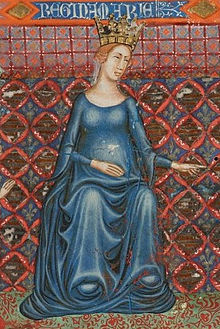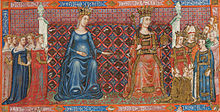
Andrew II, also known as Andrew of Jerusalem, was King of Hungary and Croatia between 1205 and 1235. He ruled the Principality of Halych from 1188 until 1189/1190, and again between 1208/1209 and 1210. He was the younger son of Béla III of Hungary, who entrusted him with the administration of the newly conquered Principality of Halych in 1188. Andrew's rule was unpopular, and the boyars expelled him. Béla III willed property and money to Andrew, obliging him to lead a crusade to the Holy Land. Instead, Andrew forced his elder brother, King Emeric of Hungary, to cede Croatia and Dalmatia as an appanage to him in 1197. The following year, Andrew occupied Hum.

Charles I, also known as Charles Robert, was King of Hungary and Croatia from 1308 to his death. He was a member of the Capetian House of Anjou and the only son of Charles Martel, Prince of Salerno. His father was the eldest son of Charles II of Naples and Mary of Hungary. Mary laid claim to Hungary after her brother, Ladislaus IV of Hungary, died in 1290, but the Hungarian prelates and lords elected her cousin, Andrew III, king. Instead of abandoning her claim to Hungary, she transferred it to her son, Charles Martel, and after his death in 1295, to her grandson, Charles. On the other hand, her husband, Charles II of Naples, made their third son, Robert, heir to the Kingdom of Naples, thus disinheriting Charles.

Stephen V was King of Hungary and Croatia between 1270 and 1272, and Duke of Styria from 1258 to 1260. He was the oldest son of King Béla IV and Maria Laskarina. King Béla had his son crowned king at the age of six and appointed him Duke of Slavonia. Still a child, Stephen married Elizabeth, a daughter of a chieftain of the Cumans whom his father settled in the Great Hungarian Plain.
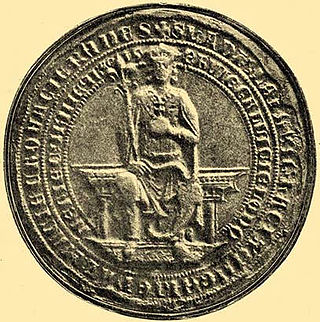
Ladislaus IV, also known as Ladislaus the Cuman, was King of Hungary and Croatia from 1272 to 1290. His mother, Elizabeth, was the daughter of a chieftain from the pagan Cumans who had settled in Hungary. At the age of seven, he married Elisabeth, a daughter of King Charles I of Sicily. Ladislaus was only 9 when a rebellious lord, Joachim Gutkeled, kidnapped and imprisoned him.

Wenceslaus III was King of Hungary and Croatia between 1301 and 1305, and King of Bohemia and Poland from 1305. He was the son of Wenceslaus II, King of Bohemia, who was later also crowned king of Poland, and Judith of Habsburg. Still a child, Wenceslaus was betrothed to Elizabeth, the sole daughter of Andrew III of Hungary. After Andrew III's death in early 1301, the majority of the Hungarian lords and prelates elected Wenceslaus king, although Pope Boniface VIII supported another claimant, Charles Robert, a member of the royal house of the Kingdom of Naples.
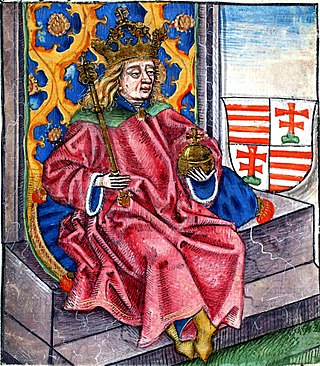
Béla IV was King of Hungary and Croatia between 1235 and 1270, and Duke of Styria from 1254 to 1258. As the oldest son of King Andrew II, he was crowned upon the initiative of a group of influential noblemen in his father's lifetime in 1214. His father, who strongly opposed Béla's coronation, refused to give him a province to rule until 1220. In this year, Béla was appointed Duke of Slavonia, also with jurisdiction in Croatia and Dalmatia. Around the same time, Béla married Maria, a daughter of Theodore I Laskaris, Emperor of Nicaea. From 1226, he governed Transylvania as duke. He supported Christian missions among the pagan Cumans who dwelled in the plains to the east of his province. Some Cuman chieftains acknowledged his suzerainty and he adopted the title of King of Cumania in 1233. King Andrew died on 21 September 1235 and Béla succeeded him. He attempted to restore royal authority, which had diminished under his father. For this purpose, he revised his predecessors' land grants and reclaimed former royal estates, causing discontent among the noblemen and the prelates.

Ladislaus III was King of Hungary and Croatia between 1204 and 1205. He was the only child of King Emeric. Ladislaus was crowned king upon the orders of his ill father, who wanted to secure his infant son's succession. The dying king made his brother, Andrew, regent for the period of Ladislaus's minority. However, Duke Andrew ignored the child's interests. As a result, Ladislaus's mother, Constance of Aragon, fled to Austria, taking Ladislaus with her. Ladislaus died unexpectedly in Vienna.
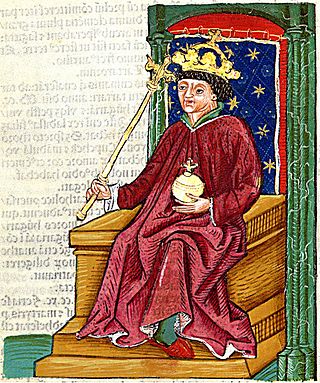
Andrew III the Venetian was King of Hungary and Croatia between 1290 and 1301. His father, Stephen the Posthumous, was the posthumous son of Andrew II of Hungary although Stephen's older half brothers considered him a bastard. Andrew grew up in Venice, and first arrived in Hungary upon the invitation of a rebellious baron, Ivan Kőszegi, in 1278. Kőszegi tried to play Andrew off against Ladislaus IV of Hungary, but the conspiracy collapsed and Andrew returned to Venice.

The Capetian House of Anjou, or House of Anjou-Sicily, or House of Anjou-Naples was a royal house and cadet branch of the Capetian dynasty. It is one of three separate royal houses referred to as Angevin, meaning "from Anjou" in France. Founded by Charles I of Anjou, the youngest son of Louis VIII of France, the Capetian king first ruled the Kingdom of Sicily during the 13th century. The War of the Sicilian Vespers later forced him out of the island of Sicily, leaving him with the southern half of the Italian Peninsula, known as the Kingdom of Naples. The house and its various branches would go on to influence much of the history of Southern and Central Europe during the Middle Ages until it became extinct in 1435.
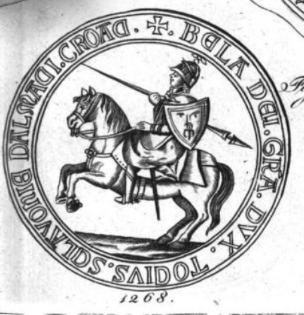
Béla was the youngest and favorite child of King Béla IV of Hungary. His father appointed him Duke of Slavonia in 1260, but he only started to govern his duchy from 1268. He died childless.
Andrew of Hungary was Prince of Galicia–Volhynia between 1227 and 1230, and between 1231 and 1234, and Prince of Zvenyhorod in 1226.
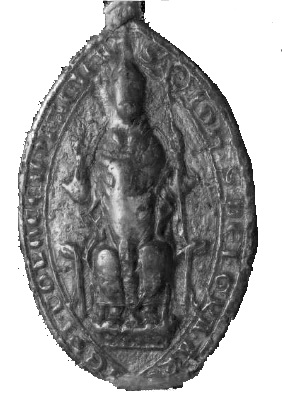
John Hont-Pázmány was a prelate in the Kingdom of Hungary at the turn of the 13th and 14th centuries. He was Archbishop of Kalocsa between 1278 and 1301. In this capacity, he closely cooperated with fellow Archbishop Lodomer in order to restore royal authority over the kingdom. After Lodomer's death, John became head of the royal council from 1298 to 1301, initiating profound constitutional changes in the parliamentary system. He crowned Wenceslaus, one of the pretenders to Hungary, king in 1301, provoking the wrath of the Holy See.

Ivan Kőszegi was an influential lord in the Kingdom of Hungary at the turn of the 13th and 14th centuries. Earlier historiographical works also refer to him Ivan Németújvári. He was Palatine in 1281, between 1287 and 1288, and from 1302 until 1307, Ban of Slavonia in 1275, from 1284 until 1285 and in 1290, and Master of the treasury in 1276 and 1291.
Andrew, Duke of Slavonia was the youngest son of King Stephen V of Hungary and his wife, Elizabeth the Cuman. Two rebellious lords kidnapped him in 1274 in an attempt to play him off against his brother, Ladislaus IV of Hungary, but the king's supporters liberated him. He was styled "Duke of Slavonia and Croatia" in a 1274 letter. Years after his death, two adventurers claimed to be identical with Andrew, but both failed.
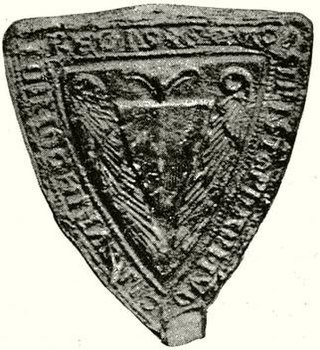
Stephen (I) from the kindred Ákos was an influential baron in the Kingdom of Hungary in the late 13th century and the early 14th century. He was born into an ancient Hungarian clan. He was a staunch supporter of Andrew III of Hungary. He served as Judge royal between 1298 and 1300, and Palatine of Hungary from 1301 to 1307.
Arnold (III) from the kindred Hahót was a Hungarian noble.
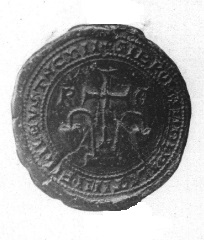
Roland (II) from the kindred Rátót was a Hungarian baron at the turn of the 13th and 14th centuries. He was one of the seven barons in the early 14th century, who were styled themselves Palatine of Hungary. He was the ancestor of the Jolsvai family.
Henry (II) Kőszegi was a Hungarian influential lord at the turn of the 13th and 14th centuries. He was a member of the powerful Kőszegi family. He extended his influence over Upper Slavonia since the 1280s, becoming one of the so-called "oligarchs", who ruled their dominion de facto independently of the monarch. After the extinction of the House of Árpád, he participated in the dynastic struggles. He drew Southern Transdanubia under his suzerainty by then.

Theodore Tengerdi was a Hungarian prelate at the turn of the 13th and 14th centuries, who served as Bishop of Győr from 1295 to 1308. Prior to that, he was provost of Székesfehérvár and vice-chancellor in the royal court, and briefly elected Bishop of Vác.
Lawrence (II) from the kindred Aba was a Hungarian nobleman in the 13th century, who served as Master of the treasury three times in the court of Ladislaus IV of Hungary. He was the forefather of the Atyinai noble family, which flourished until the mid-15th century.
